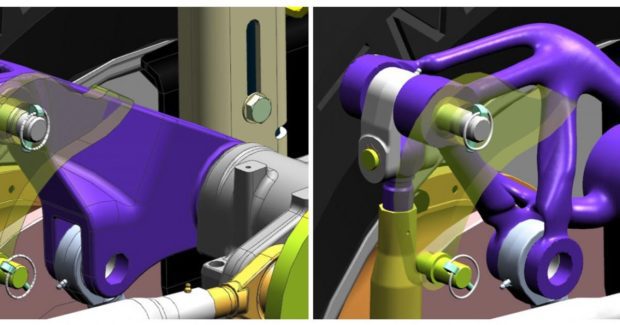Unleash a 3D Printing Revolution in Your Shop
By greatly simplifying work with geometry that combines facets, surfaces and solids, Convergent Modeling from Siemens PLM Software helps optimize part design for 3D printing, speed up the overall design process and provide scan-to-print functionality for more efficient reverse engineering.
Posted: February 21, 2017
Siemens PLM Software, Inc. (Plano, TX) announces new comprehensive technology that unleashes the full potential of the burgeoning additive manufacturing revolution. Comprised of integrated design, simulation, digital manufacturing, data and process management software that helps shops fully leverage the benefits of the latest 3D printing advancements, this technology uses smart product models through all phases without the need for conversion or translation between applications or processes. It enables automated generative design using new topology optimization capabilities that often result in organic shapes that would be difficult for a human designer to envision and impractical or impossible to produce with traditional manufacturing techniques. This technology, combined with Siemens’ new advanced additive manufacturing software, enables shops to reshape everything for optimal performance at a reduced cost.
This new additive manufacturing technology includes NX™ software, an integrated computer-aided design, manufacturing and engineering (CAD/CAM/CAE) solution; the newly announced Simcenter™ portfolio, a robust suite of simulation software and test solutions; Teamcenter® software, the world’s most widely used digital lifecycle management system; and SIMATIC IT Unified Architecture Discrete Manufacturing and SIMATIC WinCC, two elements of the Manufacturing Operations Management (MOM) portfolio for production execution and manufacturing automation.
Convergent Modeling and topology optimization are two new capabilities that enable automated generative design. Convergent Modeling is a new modeling paradigm that helps engineers optimize part design for 3D printing, speed up the overall design process and provide scan-to-print functionality that makes reverse engineering more efficient. It greatly simplifies the ability to work with geometry consisting of a combination of facets, surfaces and solids, without the need for time-consuming data conversion. Topology optimization helps analysts automate the iterative process for designing and optimizing parts for multi-physics performance, including vibration, fluid dynamics and heat transfer. Its integrated simulation and predictive engineering analytics capabilities help evaluate the design for manufacturability to provide greater confidence needed to move forward with designs optimized for additive manufacturing.
A new 3D print preparation solution for both metal and plastic parts uses the same smart product models from the design and simulation phase to help automate design changes and streamline the entire process. This new solution assists operators in preparing parts for powder bed and multi-jet fusion printing. For 3D printed metal parts, NX provides model preparation for laser metal deposition and NC programming and includes simulation for hybrid additive machine tools, where metal deposition is incorporated with subtractive methods in a single machine tool environment. For extruded materials, such as plastics and carbon fiber reinforced nylon, a new multi-axis robotic fused deposition modeling (FDM) programming technology has been developed and is being field tested. After parts are printed, the same integrated NX system is used for post-printing NC operations, such as intuitively programming the removal of support structures, machining of precision https://youtu.be/jljEbvOIEyQsurfaces and other processing and inspection operations.
These abilities to 3D print an optimized part shape can also reduce the number of parts in an assembly, thereby decreasing weight and increasing strength. As a result, industries such as automotive, aerospace and medical devices can realize dramatic value. “The additive manufacturing envelope is being pushed to create functionally optimized geometry that is inconceivable based on conventional design and manufacturing methods,” said Dr. Ken Versprille, an executive consultant at CIMdata (Ann Arbor, MI). “Previously unsolvable design and manufacturing challenges are now quite feasible with these new software and production technologies. A vision of how the technology fits together from end-to-end is becoming a reality to move the industry forward.”
Designers are trained to create parts with traditional production technologies in mind that can limit creativity and innovation. Today, production parts are either stamped, molded, cast or machined. By providing engineers and designers with a completely new way to design and manufacture parts, AM technologies are helping them reimagine the next generation of products. Manufacturers can create unique, better performing designs with significantly increased strength/weight ratios and apply advanced integrated simulation and analysis technology to predict design performance. This new transformative technology will help increase design innovation. “In order to make additive manufacturing a true industrial production process, manufacturers need to have seamless digital integration across design, production and automation, including control and monitoring of machine performance,” noted Joachim Hoedtke, the chief executive officer of Hoedtke GmbH & Co. KG (Pinneberg, Germany), an innovator in 3D printing and a Siemens customer. “Siemens is bringing together multiple software tools with new technologies focused on additive manufacturing to help accomplish this goal.”
Siemens PLM Software, Inc., 5800 Granite Parkway, Suite 600, Plano, TX 75024, 972-987-3000, Fax: 972-987-3397, www.siemens.com/plm.















